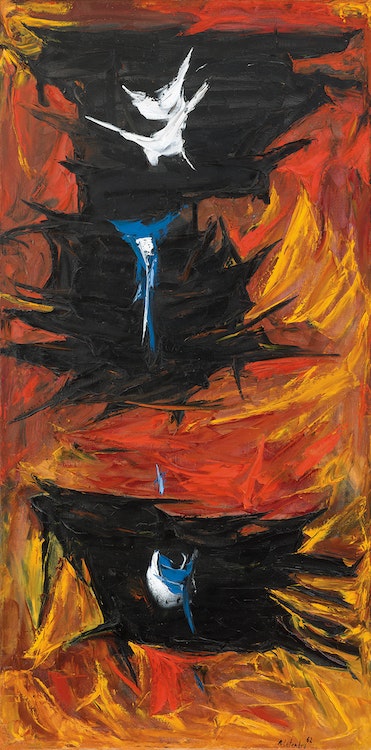Beginning as an Automatiste painter in the 1950s, Rita Letendre was influenced by Paul-Émile Borduas’ revolutionary gestural abstract paintings of the period. Although the Automatistes were instrumental in the evolution of her style, Letendre developed a singular vision in her body of work that resulted in a unique style that pushed boundaries of colour, light and space. After being exposed to the major figures of the Plasticiens movement in the mid-1950s, Letendre began experimenting with more structured and geometric compositions. However, by the end of the decade, she returned to a gestural approach, inspired by the Abstract Expressionists in New York‒particularly the black and white paintings of Franz Kline. Her production began to increase, winning first prize in the Concours de la Jeune Peinture in 1959 and the Prix Rodolphe-de-Repentigny in 1960. This prize and the additional sales that followed would allow Letendre to dedicate herself to painting full-time. Always experimenting, she worked in all media while regarding representation in art as “a crutch”.

“Rencontre enflammée”, dating to 1962, was completed during this pivotal period of growth in Letendre’s career. As she became better equipped with painting materials and more time to work, she began creating larger canvases with explosions of colour. Letendre had recently won second prize in the painting category in the 1961 Concours artistiques du Québec. Her compositions grew to be very personal and carefully planned, and she began anchoring masses with carefully visualized gestures, amid fields of thick impasto. Dramatic and evocative, Rencontre enflammée is composed of three vertically stacked black organic forms with small, loose strokes of blue and white painted over them. Behind these black masses is a striking ground of yellow and red thrashes that are reminiscent of flames, recalling Letendre’s title which translates to “fiery encounter”. On her use of colour and light, the artist claimed: “Light and colour, and sometimes the absence of colour, have always been the key elements in my painting. With its different values, colour reflects the shades of life. But light, from the first shock of birth to the last breath of life‒light is life.” In this canvas, Letendre plays with this relationship between light, colour and the absence of colour: the three black forms create haunting voids that are encompassed by the mesmerizing light of flames.
Although the title Letendre chose for “Rencontre enflammée” makes reference to a representational subject, her paintings of this time were very much still based in Automatism rather than on a particular subject. She stated, “My thoughts, my attitudes are automatist, which means that I have no set formula. My paintings are completely emotional, full of hair-trigger intensity. Through them, I challenge space and time. I paint freedom, escape from the here and now, from the mundane…The world isn’t only what we see or what we experience.”
The 1960s was a decade of well-deserved recognition for Letendre’s work, beginning with a solo exhibition at the Montreal Museum of Fine Arts in 1961. In 1962, when “Rencontre enflammée” was completed, Letendre received a Canada Council Grant, and travelled with Ulysse Comtois to Europe, visiting Paris, Rome and then Israel.
As the Automatiste group and its affiliates began to abandon their commitment to spontaneity in favour of a more controlled and deliberate structure, Letendre chose to maintain the impulsive and expressive brushstrokes in her work. Letendre kept a fairly consistent palette of dramatic colours, often with large masses of black, until the mid-1960s when she took a decisive shift into geometric compositions once again.


